Rules and Regulations for the Formations, Field Exercise, and Movements of His Majesty's Forces 1792
The British used the Rules and Regulations 1792, without substantial change, throughout the period and beyond. Indeed, having been on 'both ends of a pace-stick' during my late military career, I can say that although the style of foot drill and the manual of arms have changed, and some of the conversions have disappeared from the modern ceremonial repertoire, much of the Rules and Regulations 1792 would still be familiar to the British soldier of the late 20th Century. Other than an apparent propensity for wheeling backwards at every available opportunity, there is little, if anything, to be found in the Rules and Regulations 1792 that is not also found elsewhere.
It is received wisdom to the effect that the Rules and Regulations 1792 were such that British infantry was unable to manoeuvre with the same alacrity as its peers. If this is true, and I suspect that this is another modern myth, it had little to do with the regulations which are as versatile as any. The battalion consisted of ten companies, each of which formed a tactical platoon, sometimes called a division, consisting of two half-companies, called sub-divisions. Each sub-division consisted of two sections. The battalion could also be organised in grand-divisions, a tactical sub-unit consisting of two platoons. Ordinary time was 75 paces to minute but most conversions, and generally where speed was required, were conducted at quick time of 108 paces to the minute. Wheeling, however, was conducted in quickest time of 120 paces to the minute. [39]
It was usual for wheels from line to column to be carried out backwards and from column to line forwards.
"It may be considered as a rule almost general that all wheels of the battalion, or line (when halted and the divisions do not exceed 16, or 18 files) into column, should be backward. And all wheels from column into line forward. The only necessary exceptions seem to be in narrow ground, where there is not room for such wheels".
The basics of wheeling with a moving pivot are described in the training of recruits at Part One of the Rules and Regulations 1792 thus, and it really sums up all that has already been said about it. Where room was limited, forming could be used.
Wheeling with a Moving Pivot - Wheeling of a Single Rank on a moveable Pivot. [40]
"In wheeling on a moveable pivot, both flanks are moveable, and describe concentric circles round a point, which is removed a few paces from what would otherwise be the standing flank."
Eyes were turned to the directing flank, that is to say the flank from which the rank took its dressing, regardless of whether this was the pivot or wheeling flank.
The words of command were, "Right (or Left) Shoulders forward", carried out as described above. When facing the required direction the order, "Forward" was given again. Shoulders were then squared and the march continued towards the new front. It is noted that wheeling with a moving pivot was used thus, "when a column of march (in order to follow the windings of its route), changes direction in general, less than the quarter circle." [41]
This is repeated at Part III describing the same manoeuvre by the battalion, except that the caveat is added that a moveable pivot is only "occasionally ordered in the column of manoeuvre when its front is small" and "when the column of sections, sub-divisions or companies, is obliged frequently to change its direction of march." [42]
This apparent lack of enthusiasm for the moving pivot is repeated in a later document.
"Wheels in column of route on a moveable pivot. When the head of a column of march changes its direction, and that marching in an alignment is not in question, instead of making regular wheels on a fixed pivot, the officer who conducts the leading division will often be directed gradually to bring it round into the new direction, by the turn of the outward shoulder, making both his flanks continue moveable; but each succeeding division, without the formality of command or halt, does the same thing, the whole attention resting on each pivot flank, which at no rate must increase its distance; but during this operation preserves the same equality of time and length of step at which it was before moving". [43]
When a sub-unit wheeled on a moving pivot the orders were the same, being guided by its officer commanding. Each subsequent division wheeled on the same point and followed the exact path of the first. [44]
Forming - Forming to the Front from File. [45]
The principle of forming was also well known in the British service and is described in identical terms in both documents examined here. In the British service at this period it appears to have been used "in situations where it may have been necessary to order an extension of files (such as will sometimes occur in marching through the streets of a town)". [46]
In other words, when the sub-units were marching in column of files because of obstacles of some description, bridges, defiles and so on. In order to reform in sub-units to the front the command, "Front form platoons/sub-divisions/-sections" was given.
The front man of the leading file (right flank of the sub-unit in line) halted and was covered by the rear men of his file. All the other files the executed a half face left (left incline) and marched onto the alignment dressing on the right flank file, on completion of which the officer commanding ordered, "Eyes left."
A manoeuvre very similar to this is also described and illustrated in the French Règlement 1791 and is shown at Illustration 9 to this article.47 Forming to a flank was also in the British repertoire as shown in Illustration 9 Fig 2.
Forming - Change of Position by forming files to a flank. [48]
The cautionary was, "Battalion" followed by "To the right face", whereupon the sub-units in line executed a right turn placing them in columns of files. There then followed, "Form open column of companies" and each company formed to a flank by files, after which "Halt" and "Dress" were given.
Although technically possible the British do not appear to have used forming to change direction of a column on the march during the Napoleonic period, as did the French, and the Austrians and Prussians from 1807 and 1812 respectively.
Before proceeding, however, I'll deal with Garry's other question about British deployment from column, which is not entirely inappropriate since it does involve wheeling. The simple answer is that the British didn't always manoeuvre in open column or always deploy from closed column. The Rules and Regulations 1792 do, indeed, describe perpendicular conversions from open column to line.
Wheeling with a Stationary and a Moving Pivot - When from Open Column, the Companies Wheel backward, to Echelon, in order to form in Line on the Head Company. [49]
Conducted at ordinary time, when the leading company (assumed here to be the right flank) arrived on the new alignment it either stood fast or was wheeled on a stationary pivot into the intended alignment.
The column now being halted the cautionary was given, "Companies, wheel backward, x paces, on the right".
On the executive command, "March".
The leading company stood fast whilst those to its rear wheeled back the stated number of paces as directed, using a stationary pivot, and were halted and dressed, "Halt, Dress". followed by the command, "The column will march in echelon, to form line on the first company" "March," upon which the companies marched directly forward until 7 or 8 paces from the new alignment when the order, "Left Shoulders forward", was given, the executive "forward" on the point where the manoeuvre was to take place.
The pivot marched, maintaining the cadence, moving on a narrow arc whilst individuals inclined to the indicated direction and the company was brought round by the wheeling flank stepping out to a 33 inch pace, until it was parallel with the new alignment, the pivot flank touching the flank of the preceding company, when,
"Halt, dress up" was given and it marched into place in the line dressing on the "distant given point" (point de vue).
When within 7 or 8 paces of the alignment, the rear companies were ordered "Right shoulders forward", and "Halt", followed by "dress up".
The leading companies received the order, "Right shoulders forward", and "Halt", followed by "Front" whereupon they executed an about turn. The order was then given "Dress back." and the leading companies dressed backwards into the new alignment.
Changing the position of a line was carried out in similar fashion using an echeloned manoeuvre.
Wheeling with a Stationary and a Moving Pivot - When the Battalion changes Position to the Front, on a fixed Flank Company, by throwing forward the rest of the Battalion.
The first thing to be done was to wheel the fixed flank company into the new alignment. This also determined the number of paces necessary for the remainder. Having done this, assuming the manoeuvre being carried out on the left flank company, they were ordered, "Companies wheel forward x paces to the left". "Quick March"
It certainly appears the case, nevertheless, that the most common form of deployment, as far as the Rules and Regulations 1792 are concerned anyway, was from close column 'en tiroir' (see FE16) which is described as,
"The quickest, most exact, and general method of deployments....." [55]
Rules and Regulations 1792 also describes perpendicular open column to line conversions by means of an oblique march 'en éventail' which, unlike other column to line conversions, was conducted on the march. This did not involve wheeling and was conducted using the oblique step.
The evantail deployment using the oblique step - "When the Battalion changes Position by breaking into Open Column. Marching up perpendicular to the new Line, and to the Point where its Head is to rest, and forming in the new Position by the Evantail or Fan Movement". [56]
When the leading company was approximately a battalions length from the alignment it shortened its step to a half pace as soon as the battalion received the command, "To the right/left oblique", followed by the executive "Forward".
The rear companies obliqued to the given flank until they were in line with the leading sub-division and opposite their places in the line when the too took up the half pace, on the command, "Half Step".
When the line was complete and "Halt." was given. This conversion sounds very similar to column to line conversions conducted by the Austrians, discussed in FE25.
Changing direction of an open column on the march could also be conducted on a fixed central company.57
Wheeling with a Stationary and Moving Pivot - When a Battalion in Open Column changes its Position on any Central fixed Company. [58]
This conversion was a combination of a number other manoeuvres covered elsewhere in the regulations. Smirke gives the commands as follows. The cautionary command for a change of position to the left was,
"The column will change its direction to the left."
As each company reached the point where the change of direction was to take place it would be given the order, "Right shoulders forward" and wheeled as above using a stationary pivot in the normal way until it was facing the required direction when shoulders were squared upon the command "Forward",
Once the requisite proportion of the battalion had conducted the wheel the command
"Halt" was given.
The manoevre is shown at right. [59] A nearly identical manoeuvre is shown in the French Règlement 1791. [60]
The King's German Legion used the same methods for wheeling, their regulations being essentially a translation of the British as evidenced by this example.
Wheeling with a Moving Pivot - Von der Successiven oder Bogenschwenkung. (Of the successive or Curved Wheel). [61]
The cautionary was, "Rechte oder (Linke) Schulter!" ("Right or (Left) Shoulder!") and on reaching the point where the manoeuvre was to be performed, the executive, "Vor"! ("forward") upon which the indicated shoulder was advanced. On reaching the desired new direction the command, "Grade!" followed by "Aus!" ("Straight On!") was given.
Wheel Continued
Back to Table of Contents -- First Empire #28 This article appears in MagWeb (Magazine Web) on the Internet World Wide Web.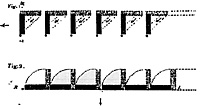 A battalion in line changing position by means of converting to open column by forming with files is described and illustrated in Smirke at Fig 1 to Manoeuvre XI, which is reproduced at right.
A battalion in line changing position by means of converting to open column by forming with files is described and illustrated in Smirke at Fig 1 to Manoeuvre XI, which is reproduced at right.
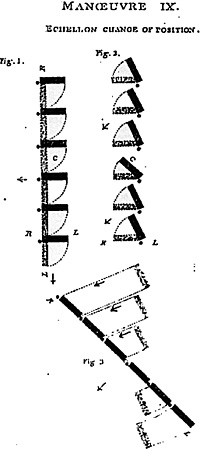 In this manner, the open column could be deployed on an infinite variety of alignments on either the rear, front or a central company. The conversion conducted on a central company is at right. [50] In this case after the companies had completed the initial wheel, the leading companies only would be ordered, "Leading companies to the right about face." [51] This placed them in the retired position. Then, "The column will march in echelon, to form line on the fourth company." "March".
In this manner, the open column could be deployed on an infinite variety of alignments on either the rear, front or a central company. The conversion conducted on a central company is at right. [50] In this case after the companies had completed the initial wheel, the leading companies only would be ordered, "Leading companies to the right about face." [51] This placed them in the retired position. Then, "The column will march in echelon, to form line on the fourth company." "March".
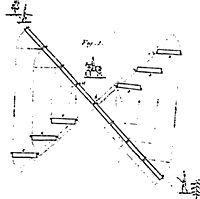 A linear central change of position from the French Règlement 1791 is at left. [52]
A linear central change of position from the French Règlement 1791 is at left. [52]
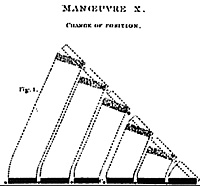 The rest of the manoeuvre was carried out in identical manner to that described for echelon deployment from open column. A diagram showing such a change of position in line is at right. [53] A rearward linear movement was also possible and was conducted on essentially the same principles. The initial break of the line was done by having the companies wheel backwards.
The rest of the manoeuvre was carried out in identical manner to that described for echelon deployment from open column. A diagram showing such a change of position in line is at right. [53] A rearward linear movement was also possible and was conducted on essentially the same principles. The initial break of the line was done by having the companies wheel backwards.
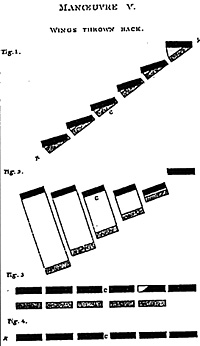 They were then retired by means of an about turn and marched into the new alignment as previously described. One dressed on the fixed company, they were advanced by means of a further about turn. This is shown at left. [54]
They were then retired by means of an about turn and marched into the new alignment as previously described. One dressed on the fixed company, they were advanced by means of a further about turn. This is shown at left. [54]
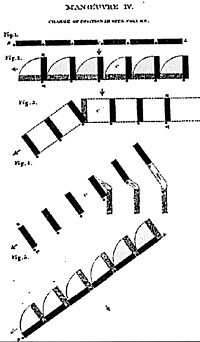 The rear companies which had not yet conducted the wheel were given the cautionary, "Rear companies will file into the new alignment." Followed by, "Rear companies, right face." and "Quick march", whereupon they filed into position on moving pivots behind the leading companies at quick time.
The rear companies which had not yet conducted the wheel were given the cautionary, "Rear companies will file into the new alignment." Followed by, "Rear companies, right face." and "Quick march", whereupon they filed into position on moving pivots behind the leading companies at quick time.
Introduction
Life Before Cadence
Wheeling With a Stationary Pivot
Wheeling With a Moving Pivot
The Regulations: France
The Regulations: Prussia
The Regulations: Austria
The Regulations: Britain and KGL
Summary and Conclusions
Footnotes
[39] Rules and Regulations for the Formations, Field-Exercise, and Movements of His Majesty's Forces 1792. Second Edition, London, 1794. pp7-8 and pp16-17.
[40] Ibid. p23.
[41] Ibid. p25.
[42] Ibid. pp100-101.
[43] Rules and Regulations for the Manual and Platoon Exercises, Formations, Field-Exercise and Movements of His Majesty's Forces for the use of the Non-commissioned Officers of the British Army. London, 1807. p101.
[44] Ibid. p62. This repeats the instructions in Rules and Regulations for the Formations etc 1792.
[45] Rules and Regulations for the Formations etc. op. cit. pp65-67 and Ibid, pp70-72.
[46] Ibid. p65.
[47] Règlement 1791. op. cit. Planche VII Figs 2 and 3. Illustration 9 was reproduced from the Westphalian regulations.
[48] Smirke, R. Review of a Battalion of Infantry including the Eighteen Manoeuvres. London, 1810. Manoeuvre XI, Pl14. Smirke's manual describes the various manoeuvres a battalion was to perform at review.
[49] Rules and Regulations for the Formations etc. op. cit. pp253-258.
[50] Smirke. op. cit. Manoeuvre IX, Pl13.
[51] An about face or about turn is almost always executed to the right everywhere.
[52] Règlement 1791. op. cit. Ecole de Bataillon, Fig 1 Planche XXV.
[53] Smirke. op. cit. Manoeuvre X, P114.
[54] Smirke. op. cit. Manoeuvre V, P18.
[55] Rules and Regulations for the Formations etc. op. cit. p234-237.
[56] Ibid. pp209-210.
[57] Ibid. op. cit. p212.
[58] Règlement 1791. op. cit. Ecole de Bataillon, Planche XIV and p37.
[59] Smirke. op. cit. p23 and Rules and Regulations for the Formations etc. op. cit. pp212-213.
[60] Smirke. op. cit. Manoeuvre IV, Plate 7, Figs 4 and 5.
[61] Exerzir-Reglement für die leichte Infanterie der Königlich--Großbrittannischen Teutschen Legion. London, 1813. p31.
Back to Table of Contents -- First Empire #29
© Copyright 1996 by First Empire.
Other military history articles and gaming articles are available at http://www.magweb.com